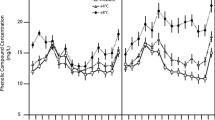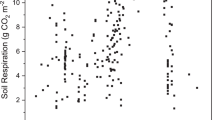Abstract
Aims
Plant growth forms can influence carbon cycling, particularly in carbon-rich ecosystems like northern peatlands; however, mechanistic evidence of this relationship is limited. Our aim was to determine if northern peatland plant growth forms alter belowground dissolved carbon chemistry and enhance carbon release through stimulated microbial metabolism.
Methods
We used replicated, peat monoliths populated exclusively by Sphagnum mosses, graminoids, or bare peat and quantified changes in belowground dissolved organic carbon chemistry, microbial metabolism, as well as respired CO2.
Results
The graminoid growth form was significantly distinct in belowground dissolved organic carbon chemistry with carbon compound lability 20 % and 11 % greater than bare peat and Sphagnum moss respectively. The labile dissolved organic carbon stimulated the microbial community, as indicated by greater microbial metabolic activity and richness values in conjunction with 50 % higher respired CO2 fluxes under the graminoid treatment.
Conclusions
Our results provide mechanistic evidence that peatland plant growth forms can drive carbon cycling processes by altering dissolved organic carbon chemistry to prompt cascading effects on the microbial community and carbon release — trends suggestive of microbial priming effects. Should climate change increase graminoid prevalence at the expense of Sphagnum moss northern peatland carbon store stability may be threatened by this mechanism.



Similar content being viewed by others
Abbreviations
- AWCD:
-
Average well colour development
- BIX:
-
Freshness index
- CO2 :
-
Carbon dioxide
- DOC:
-
Dissolved organic carbon
- FI:
-
Fluorescence index
- HIXEM :
-
Humification index
- SOM:
-
Soil organic material
- SUVA254 :
-
Specific ultraviolet absorbance at 254 nm
References
Allison SD, Wallenstein MD, Bradford MA (2010) Soil-carbon response to warming dependent on microbial physiology. Nat Geosci 3:336–340
Armstrong A, Holden J, Luxton K, Quinton JN (2012) Multi-scale relationship between peatland vegetation type and dissolved organic carbon concentration. Ecol Eng 47:182–188
Armstrong A, Waldron S, Ostle NJ, Richardson H, Whitaker J (2015) Biotic and abiotic factors interact to regulate northern peatland carbon cycling. Ecosystems 18:1395–1409
Badri DV, Vivanco JM (2009) Regulation and function of root exudates. Plant Cell Environ 32:666–681
Bengtson P, Barker J, Grayston SJ (2012) Evidence of a strong coupling between root exudation, C and N availability, and stimulated SOM decomposition caused by rhizosphere priming effects. Eco Evol 2:1843–1852
Blagodatskaya E, Kuzyakov Y (2008) Mechanisms of real and apparent priming effects and their dependence on soil microbial biomass and community structure: critical review. Biol Fertil Soils 45:115–131
Blagodatskaya E, Yuyukina T, Blagodatsky S, Kuzyakov Y (2011) Three-source-partitioning of microbial biomass and of CO2 efflux from soil to evaluate mechanisms of priming effects. Soil Biol Biochem 43:778–786
Blagodatsky S, Blagodatskaya E, Yuyukina T, Kuzyakov Y (2010) Model of apparent and real priming effects: linking microbial activity with soil organic matter decomposition. Soil Biol Biochem 42:1275–1283
Bombonato L, Siffi C, Gerdol R (2010) Variations in the foliar nutrient content of mire plants: effects of growth-form based grouping and habitat. Plant Ecol 211:235–251
Buckeridge KM, Banerjee S, Siciliano SD, Grogan P (2013) The seasonal pattern of soil microbial community structure in Mesic low arctic tundra. Soil Biol Biochem 65:338–347
Carroll P, Crill P (1997) Carbon balance of a temperate poor fen. Global Biogeochem Cy 11:349–356
Crow SE, Wieder RK (2005) Sources of CO2 emission from a northern peatland: root respiration, exudation, and decomposition. Ecology 86:1825–1834
Davidson EA, Janssens IA (2006) Temperature sensitivity of soil carbon decomposition and feedbacks to climate change. Nature 440:165–173
Del Giudice R, Lindo Z (2017) Short-term leaching dynamics of three peatland plant species reveals how shifts in plant communities may affect decomposition processes. Geoderma 285:110–116
Dieleman CM, Branfireun BA, McLaughlin JW, Lindo Z (2015) Climate change drives a shift in peatland ecosystem plant community: implications for ecosystem function and stability. Glob Change Biol 21:388–395
Dorrepaal E (2007) Are plant growth-form-based classifications useful in predicting northern ecosystem carbon cycling feedbacks to climate change? J Ecol 95:1167–1180
Dorrepaal E, Cornelissen JHC, Aerts R, Wallén B, van Logtestijn RSP (2005) Are growth forms consistent predictors of leaf litter quality and decomposability across peatlands along a latitudinal gradient? J Ecol 93:817–828
Dorrepaal E, Toet S, van Logtestijn RSP, Swart E, van de Weg MJ, Callaghan TV, Aerts R (2009) Carbon respiration from subsurface peat accelerated by climate warming in the subarctic. Nature 460:616–620
Dunn C, Jones TG, Roberts S, Freeman C (2015) Plant species effects on the carbon storage capabilities of a blanket bog complex. Wetlands 36:47–58
Eppinga MB, Rietkerk M, Wassen MJ, De Ruiter PC (2009) Linking habitat modification to catastrophic shifts and vegetation patterns in bogs. Plant Ecol 200:53–68
Fan Z, McGuire AD, Turetsky MR, Harden JW, Waddington JM, Kane ES (2013) The response of soil organic carbon of a rich fen peatland in interior Alaska to projected climate change. Glob Change Biol 19:604–620
Faubert P, Rochefort L (2002) Response of peatland mosses to burial by wind-dispersed peat. Bryologist 105:96–103
Fellman JB, Hood E, Spencer RGM (2010) Fluorescence spectroscopy opens new windows into dissolved organic matter dynamics in freshwater ecosystems: a review. Limnol Oceanogr 55:2452–2462
Fenchel T, King GM, Blackburn H (1998) Bacterial biogeochemistry: the Ecophysiology of mineral cycling. Academic Press, San Diego
Fenner N, Freeman C, Lock MA, Harmens H, Reynolds B, Sparks T (2007a) Interactions between elevated CO2 and warming could amplify DOC exports from peatland catchments. Environ Sci Technol 41:3146–3152
Fenner N, Ostle NJ, McNamara N, Sparks T, Harmens H, Reynolds B, Freeman C (2007b) Elevated CO2 effects on peatland plant community carbon dynamics and DOC production. Ecosystems 10:635–647
Fontaine S, Barot S, Barré P, Bdioui N, Mary B, Rumpel C (2007) Stability of organic carbon in deep soil layers controlled by fresh carbon supply. Nature 450:277–281
Frąc M, Oszust K, Lipiec J (2012) Community level physiological profiles (CLPP) characterization and microbial activity of soil amended with dairy sewage sludge. Sensors 12:3253–3268
Garland JL (1996) Analytical approaches to the characterization of samples of microbial communities using patterns of potential C source utilization. Soil Biol Biochem 28:213–221
Garland JL (1997) Analysis and interpretation of community-level physiological profiles in microbial ecology. FEMS Microbiol Ecol 24:289–300
Garland JL, Mills AL (1991) Classification and characterization of heterotrophic microbial communities on the basis of patterns of community-level sole-carbon-source utilization. Appl Environ Microbiol 57:2351–2359
Gomez-Casanovas N, Matamala R, Cook DR, Gonzalez-Meler MA (2012) Net ecosystem exchange modifies the relationship between the autotrophic and heterotrophic components of soil respiration with abiotic factors in prairie grasslands. Glob Change Biol 18:2532–2545
Gorham E (1991) Northern peatlands: role in the carbon cycle and probable responses to climatic warming. Ecol Appl 1:182–195
Griffis TJ, Black TA, Gaumont-Guay D, Drewitt GB, Nesic Z, Barr AG, Morgenstern K, Kljun K (2004) Seasonal variation and partitioning of ecosystem respiration in a southern boreal aspen forest. Agric For Meteorol 125:207–223
Gunina A, Kuzyakov Y (2015) Sugars in soil and sweets for microorganisms: review of origin, content, composition and fate. Soil Biol Biochem 90:87–100
Kalbitz K, Schmerwitz J, Schwesig D, Matzner E (2003) Biodegradation of soil-derived dissolved organic matter as related to its properties. Geoderma 113:273–291
Kuzyakov Y (2010) Priming effects: interactions between living and dead organic matter. Soil Biol Biochem 42:1362–1371
Kuzyakov Y, Friedel JK, Stahr K (2000) Review of mechanisms and quantification of priming effects. Soil Biol Biochem 32:1485–1498
Lavorel S, Garnier E (2002) Predicting changes in community composition and ecosystem functioning from plant traits: revisiting the holy grail. Funct Ecol 16:545–556
Lawaetz AJ, Stedmon CA (2009) Fluorescence intensity calibration using the raman scatter peak of water. Appl Spectrosc 63:936–940
Limpens J, Berendse F, Blodau C, Canadell JG, Freeman C, Holden J, Roulet N, Rydin H, Schaepman-Strub G (2008) Peatlands and the carbon cycle: from local processes to global implications – a synthesis. Biogeosciences 5:1475–1491
McLaughlin JW, Webster KL (2010) Alkalinity and acidity cycling and fluxes in an intermediate fen peatland in northern Ontario. Biogeochemistry 99:143–155
Philippot L, Raaijmakers JM, Lemanceau P, van der Putten WH (2013) Going back to the roots: the microbial ecology of the rhizosphere. Nat Rev Microbiol 11:789–799
Pinsonneault AJ, Moore TR, Roulet NT, Lapierre J-F (2016) Biodegradability of vegetation-derived dissolved organic carbon in a cool temperate ombrotrophic bog. Ecosystems 19:1023–1036
Robroek BJM, Albrecht RJH, Hamard S, Pulgarin A, Bragazza L, Buttler A, Jassey VEJ (2016) Peatland vascular plant functional types affect dissolved organic matter chemistry. Plant Soil 407:135–143
Rydin H, Jeglum JK (2013) The biology of peatlands 2nd ed. Oxford University Press, Oxford
Straková P, Anttila J, Spetz P, Kitunen V, Tapanila T, Laiho R (2010) Litter quality and its response to water level drawdown in boreal peatlands at plant species and community level. Plant Soil 335:501–520
Walker TN, Garnett MH, Ward SE, Oakley S, Bardgett RD, Ostle NJ (2016) Vascular plants promote ancient peatland carbon loss with climate warming. Glob Change Biol 22:1880–1889
Ward SE, Orwin KH, Ostle NJ, Briones MJI, Thomson BC, Griffiths RI, Oakley S, Quirk H, Bardgett RD (2015) Vegetation exerts a greater control on litter decomposition than climate warming in peatlands. Ecology 96:113–123
Webster KL, McLaughlin JW (2010) Importance of the water table in controlling dissolved carbon along a fen nutrient gradient. Soil Sci Soc Am J 74:2254–2266
Webster KL, McLaughlin JW, Kim Y, Packalen MS, Li CS (2013) Modelling carbon dynamics and response to environmental change along a boreal fen nutrient gradient. Ecol Model 248:148–164
Weishaar JL, Aiken GR, Bergamashi BA, Fram MS, Fujii R, Mopper K (2003) Evaluation of specific ultraviolet absorbance as an indicator of the chemical composition and reactivity of dissolved organic carbon. Environ Sci Technol 37:4702–4708
Weltzin JF, Pastor J, Harth C, Bridgham SD, Updegraff K, Chapin CT (2000) Response of bog and fen plant communities to warming and water-table manipulations. Ecology 81:3464–3478
Wiedermann MM, Nordin A, Gunnarsson U, Nilsson MB, Ericson L (2007) Global change shifts vegetation and plant-parasite interactions in a boreal mire. Ecology 88:454–464
Yu ZC (2012) Northern peatland carbon stocks and dynamics: a review. Biogeosciences 9:4071–4085
Zhu B, Gutknecht JLM, Herman DJ, Keck DC, Firestone MK, Cheng W (2014) Rhizosphere priming effects on soil carbon and nitrogen mineralization. Soil Biol Biochem 76:183–192
Acknowledgments
We are grateful to Dr. C. Dean, Dean of the Western Faculty of Science, for supporting our use of the Biotron, funding from the Natural Sciences and Engineering Research Council of Canada (NSERC) Discovery Grant program (ZL, BB), Canada Research Chairs program (BB), NSERC Strategic Network support to the Canada Network for Aquatic Ecosystem Services (BB) and the Ontario Graduate Scholarship program (CD). We thank Dr. J. McLaughlin (Ontario Ministry of Natural Resources and Forestry) for access to the White River, ON field site and his continued support with our research program. We also thank Dr. C. Oswald (Ryerson University) for advice and aid on EEMs techniques and Dr. S. Carey (McMaster University) for access to laboratory instruments.
Author information
Authors and Affiliations
Corresponding author
Additional information
Responsible Editor: Zucong Cai.
Electronic supplementary material
Rights and permissions
About this article
Cite this article
Dieleman, C.M., Branfireun, B.A. & Lindo, Z. Northern peatland carbon dynamics driven by plant growth form — the role of graminoids. Plant Soil 415, 25–35 (2017). https://doi.org/10.1007/s11104-016-3099-3
Received:
Accepted:
Published:
Issue Date:
DOI: https://doi.org/10.1007/s11104-016-3099-3




